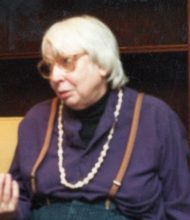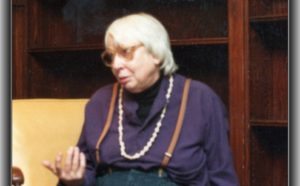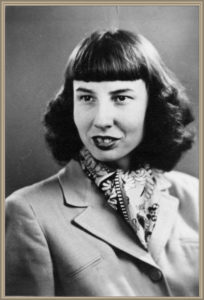

Cathernine, the Lion-Hearted
Where She Came From
Catherine Nicholson (no middle name) was born in Troy, a small town in the Scottish Presbyterian sandhills region of North Carolina, on August 7, 1922, but her father Mike, the town druggist, registered her birth as August 8th. Catherine celebrated both days.
When Catherine was four, her older sister, Edna Earle, died at home from an overdose of morphine given her during an asthma attack by a new doctor in town. The morphine had come from Mike’s drugstore, a hard fact which Catherine’s mother never forgave. She took to her bed for a year, and during that year taught Catherine to read. Catherine’s head-start on schooling and her love for literature were born out of her mother’s unassuageable grief.
To escape the thunderclouds at home, Catherine spent much of her time outside the house. She read the magazines and drank cherry cokes at the soda fountain in her father’s drugstore, and watched every Hollywood movie that came to town – for free, in her uncle’s movie theatre. She played long hours with Nancy and other friends in the neighborhood: one of their best games was Plike (short for “play like you’re x … “), a form of theatre that didn’t require adult supervision or resources. And, when her mother didn’t intervene in time, Catherine gave her toys to the other children.
Moving Out into a Wider World

Catherine Nicholson, Flora MacDonald College graduation
Catherine graduated from a small woman’s college near Troy that had been named after the 18th-century Jacobite heroine Flora MacDonald, remembered by the Scots for her courage, fidelity, and honor. Then Catherine went to the University of North Carolina at Chapel Hill for a master’s in English literature. She taught in Winston-Salem, and later showed me the campus where she’d asked WH Auden to read. He arrived on the train from New York City, and she and her roommate invited all the beautiful, intelligent young men they knew for him to converse with. Catherine herself was working seriously on poems, but Auden never knew that.
Catherine never told me when and why her passion shifted from words on the page to live theatre, but she took the extraordinary step of moving alone from North Carolina to Chicago, to study at Northwestern University under the great acting teacher Alvina Krause. Catherine earned an MA and a PhD in theatre and oral interpretation at Northwestern, writing her dissertation on the role of the chorus in Greek tragedy.
It was during those years in the Midwest that Catherine made three discoveries which would shape her life until its closing: she discovered that, though she made a good actor, she made an even better director; she discovered the books of Jane Ellen Harrison, intellectual revolutionary who uncovered the violent destruction of female-centered culture which lay at the root of Western civilization; and she discovered Barbara, then an undergraduate in sociology at Northwestern and Catherine’s first real love.
Making Theatre Live
When I met her at the Charlotte Women’s Center in 1974, Catherine had directed university theatre for nearly twenty years, first at Randolph-Macon Woman’s College in Virginia, then at the new branch of the University of North Carolina in Charlotte, where she and the painter Maud Gatewood had begun the interdisciplinary arts program. I knew that the old lovers and friends she introduced me to thought she was a great director, but I had no idea what that meant until after we were living together and she was directing what would be her final play at UNCC, “Twelfth Night,” cast irrespective of sex. I listened to her anguish night after day after night, and I watched as she created a whole world; I watched her slowly give that world over to the actors; and I watched her withdraw to let the actors in turn make that world live for their audience. I saw how what she did caused everyone touched by it to rise far above their ordinary selves. And I saw what happened when the play was done, the collapse of the collective extraordinary back into the individual ordinary.
How We Got Together and Catherine Left the University
Catherine had become fascinated with me by reading my journal (she could quote chunks of it verbatim), and I had become fascinated with her by listening to her talk. Catherine’s mind was a library, and she could talk a blue streak – from morning coffee, when she would recount fabulously detailed, richly theatrical dreams, to the last drop of bourbon nearly twenty hours later. She was fifty-three, she was at the top of her game professionally, and she drank a lot. I was twenty-eight, I lived and breathed revolution and the Charlotte Women’s Center, and I was career-less, unless you counted a part-time job as a technical writer.
We were in complete agreement that an ongoing love relationship would be a terrible idea. We were in complete agreement that my moving into her house would produce a catastrophe. We agreed completely, and then in early 1975, we went ahead and did it anyway.
After the “Twelfth Night” performances a few months later, Catherine left her tenured teaching position, explosively. In practical terms, she could have stayed. The administration was upset about the sex discrimination suit she’d filed, but they still needed her. The gay male artists who surrounded her like a Judy-Garland fan club were alarmed by the women’s center and by me, but, given time and reassurance, they would have come around. The real reason she left, I think now, was that she had reached the limits of what the patriarchal theatre tradition could do. She’d directed Greek tragedy, knowing that the stories the old plays told were stories of the defeat of women. She’d directed Shakespeare, playing with gender roles even more than he had. She’d directed Brecht and Ibsen and Strindberg and the first North American production of Beckett’s “Waiting for Godot.” She’d been there, she’d done that, and she wanted to create something new.
An Amazon Culture Center on Paper
You’d think I could tell most excellent stories about the years (1976-81) that Catherine and I did Sinister Wisdom together, but it was like being picked up by a tornado. Memory pictures swirl in my head, both of us being turned and twisted and swept away, from North Carolina to Nebraska to Massachusetts. I remember the women all along the way, lesbian-identified and not – massive presences, startling presences, stellar souls. I remember the ecstasy of break-through conversations, the traveling from lesbian home to lesbian home, the cooperative labor (many hands are supposed to make light work, but there was so much work associated with Sinister Wisdom, it needed an army and a couple of generations).
Through it all, Catherine remained in some sense the director. It was her idea that we should publish a magazine together. The resources we burned up in the process were chiefly hers. She was, essentially, the one who made Sinister Wisdom happen and the one who kept it going, most especially when I was felled by an attack of Graves’ disease in Nebraska.
Catherine was the lion-heart of Sinister Wisdom, and it is for that, more than for any other of the many gifts she gave, that I honor her and wish her to be remembered.
note: I wrote this tribute to Catherine after Julie R. Enszer, the current editor of Sinister Wisdom, e-mailed me that Catherine had just died. The news was not a surprise because it had been over a year since Catherine had been able to remember who I was, and her goddaughter had told me a few weeks earlier that Catherine had suffered a massive stroke. Surprised or not, however, I was in a state of semi-shock when I started writing this, and Julie patiently waited while I struggled through to the end.
My piece appeared along with other tributes by Marilyn Frye, Beth Hodges, and Susan Robinson (aka Susan Wood-Thompson) in Sinister Wisdom 90 (Fall 2013).
The 111th book-length issue of Sinister Wisdom arrived in my rural mailbox a few weeks ago. Wherever Catherine is now (I’ve listed her in my address book as “free in the universe”), I say to her, Remember that project we started with such trepidation in 1976? Guess what—it’s succeeding beyond our wildest imaginings.








